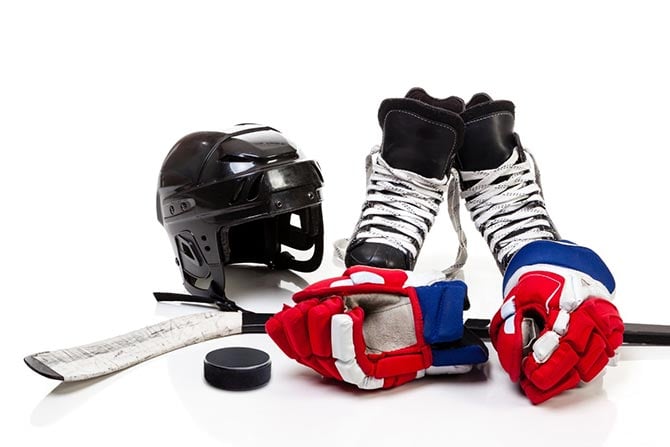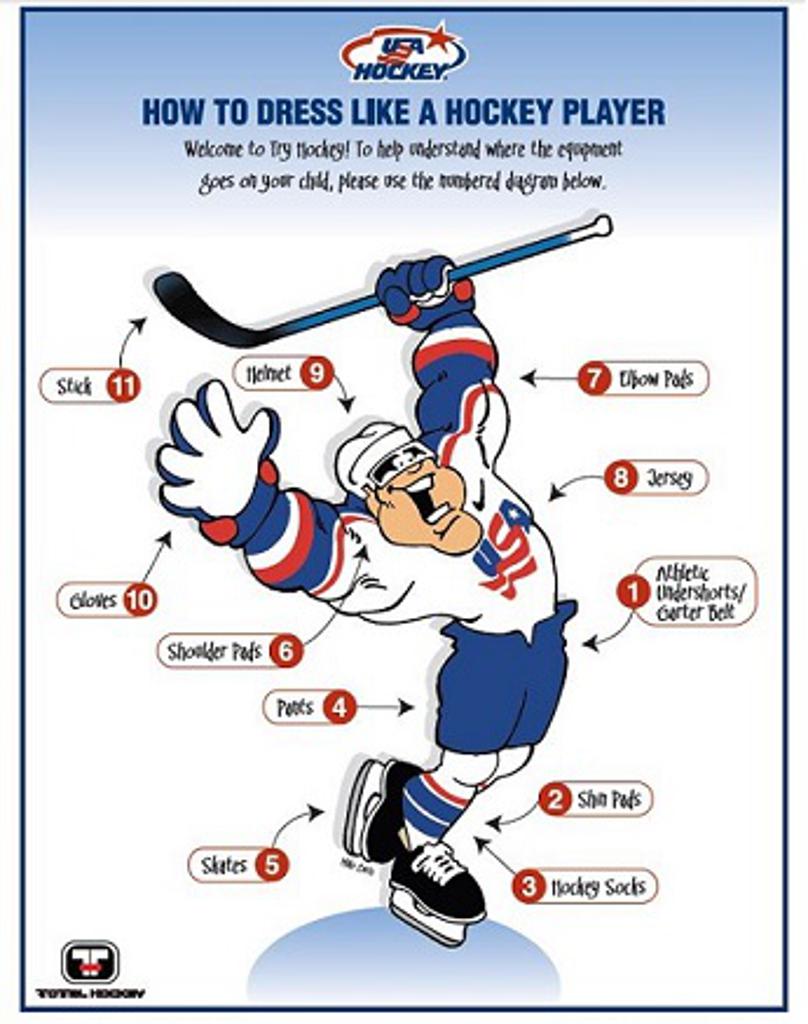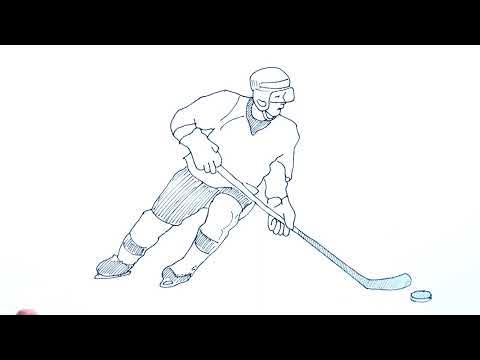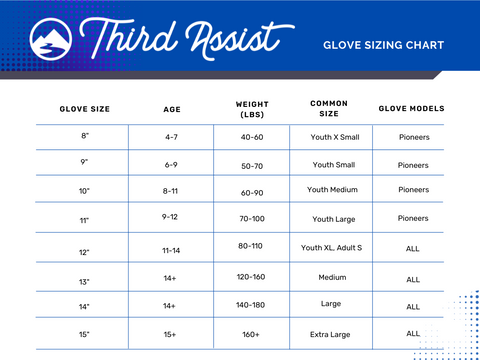Putting on ice hockey gear may seem tricky, but it’s essential for safety. Properly wearing the gear ensures you are protected and comfortable on the ice.
Ice hockey is a fast-paced, high-impact sport, making safety a top priority. Properly wearing the right gear protects you from injuries and enhances your performance. From helmets to skates, each piece of equipment has a specific role in keeping you safe.
Whether you’re a beginner or an experienced player, knowing how to correctly put on your gear is crucial. This guide will walk you through each step, ensuring you understand the importance of every piece. Get ready to hit the ice with confidence and safety!
Introduction To Ice Hockey Gear
Ice hockey is a thrilling sport that requires the right gear to stay safe and perform well. Understanding each piece of equipment is crucial for both beginners and experienced players. In this section, we’ll break down the importance of proper gear and provide an overview of the essential equipment needed for ice hockey.
Importance Of Proper Gear
Wearing the correct ice hockey gear is vital for several reasons:
- Safety: Proper gear protects players from injuries.
- Performance: Good equipment improves your game.
- Comfort: Well-fitted gear ensures you can move freely.
Without the right gear, you risk serious injuries. Helmets protect your head. Pads cushion your body. Skates allow swift movement. All these elements work together to keep you safe and enhance your performance on the ice.
Overview Of Equipment
Here is a basic list of the essential ice hockey gear:
- Helmet: Protects your head and face.
- Shoulder Pads: Guards your shoulders and upper body.
- Elbow Pads: Shields your elbows from impacts.
- Gloves: Protect your hands and provide grip.
- Skates: Allows you to move quickly on the ice.
- Shin Guards: Protects your knees and shins.
- Hockey Pants: Cushions your hips and thighs.
- Jockstrap: Provides essential protection.
- Stick: Used to control and shoot the puck.
Each piece of equipment serves a specific purpose. For instance, helmets and face masks are mandatory. They shield your head from pucks and sticks. Shoulder pads and elbow pads absorb impacts during collisions. Gloves protect your hands while allowing for stick handling. Skates are crucial for mobility on the ice.
For goalies, additional equipment is required, including chest protectors, leg pads, and a specialized glove. This gear ensures goalies can safely block pucks and perform their duties without injury.
Having a complete set of ice hockey gear is necessary for both safety and performance. Ensure each piece fits well and is in good condition before stepping onto the ice.

Credit: www.youtube.com
Preparing Your Gear
Before hitting the ice, ensure your hockey gear is ready. Proper preparation not only boosts safety but also enhances your performance. Let’s explore how to prepare your gear effectively.
Gathering Necessary Items
Start with a checklist. Gather all the essential items: skates, helmet, gloves, shoulder pads, elbow pads, shin guards, and a hockey stick. Don’t forget your hockey socks and jersey. Having everything in one place saves time and reduces stress.
Inspecting Equipment
Check each item for wear and tear. Inspect your helmet for cracks. Ensure the skates are sharp and the laces are intact. Look at your pads. Make sure they are not damaged. Confirm that all straps and fasteners work properly. Safe and functional gear is crucial for a good game.
Base Layers And Undergarments
Ice hockey gear can seem complicated, but it starts with the right base layers and undergarments. These pieces are essential for comfort, moisture control, and protection. They form the foundation of your gear, ensuring you stay dry and comfortable during the game.
Choosing The Right Base Layer
The base layer helps regulate body temperature. Choose materials like moisture-wicking fabric. These fabrics keep sweat away from your skin. Avoid cotton, as it holds moisture and can make you cold. Look for synthetic materials or merino wool for optimal performance.
Proper Fit And Comfort
Fit is crucial for your base layer. It should be snug but not too tight. A good fit allows for freedom of movement. Test the fit by stretching and moving in different directions. Ensure there are no areas of tightness or discomfort.
Comfort is key. You will wear this layer for hours. Pay attention to the seams. Flat seams are better as they reduce chafing. Make sure the fabric is soft and not itchy. Comfort and fit together enhance your performance on the ice.

Credit: www.owayo.com
Putting On Protective Pads
Properly wearing protective pads is crucial for safe ice hockey play. These pads shield your body from impacts and falls. Let’s break down the steps to wear them correctly.
Shin Guards And Socks
Start with shin guards. Place them inside your socks. Make sure they cover the front of your lower legs. Secure them with Velcro straps. Your socks go over the shin guards. This keeps them in place during the game.
Knee And Elbow Pads
Put on knee pads next. Slide them over your knees. Ensure they fit snugly but comfortably. Knee pads protect against falls and collisions.
Elbow pads come last. Slide them onto your elbows. Adjust the straps for a secure fit. Elbow pads protect your joints from hits and falls.
With these protective pads on, you are ready to play safely. Remember, comfort and fit are key for effective protection.
Securing Your Skates
Secure your skates tightly to ensure a comfortable fit. Properly laced skates help you maintain balance on the ice.
Putting on your ice hockey skates is vital for performance. Properly fitted skates give you control and stability. Let’s dive into how to secure your skates correctly.Lacing Up Skates
Start by loosening the laces. Make sure the tongue of the skate is pulled forward. Place your foot inside the skate, ensuring your heel is snug in the back. Begin lacing from the bottom, crossing the laces over each other. Pull tight with each loop.Ensuring Proper Tightness
The tightness of your laces is crucial. Your skates should feel snug but not overly tight. Begin tightening from the toe area, moving upwards. Make sure the laces are firm at the ankles. This provides necessary support. Check for comfort and adjust if needed. You want to ensure a secure fit without discomfort. “`Wearing The Jersey And Pants
Putting on your hockey gear properly ensures comfort and safety during the game. This section will guide you through the steps of wearing your jersey and pants correctly.
Putting On The Jersey
Your jersey is not just for looks; it also provides some padding. Follow these steps to put it on:
- First, make sure your shoulder pads are on and secure.
- Take your jersey and hold it by the collar.
- Slide it over your head and down your torso.
- Ensure the jersey covers your shoulder pads completely.
- Adjust the sleeves so they align with your elbow pads.
Make sure there is no tightness or restriction in movement. Your jersey should be comfortable and allow free arm movement.
Securing Hockey Pants
Hockey pants protect your hips, thighs, and tailbone. Here’s how to wear them:
- Put on your compression shorts and shin guards first.
- Step into your hockey pants, one leg at a time.
- Pull the pants up to your waist.
- Ensure the padding covers your thighs and tailbone.
- Use the belt or laces to secure the pants snugly.
Your pants should fit comfortably without sliding down. Adjust the belt or laces if needed.
| Item | Steps |
|---|---|
| Jersey |
|
| Hockey Pants |
|
Properly wearing your jersey and pants can enhance your performance. Make sure they fit well and offer the necessary protection.
Adding Upper Body Protection
Adding upper body protection is crucial for ice hockey players. Proper gear protects against injuries and allows for a safer game. This section will cover two essential pieces of upper body protection: shoulder pads and a chest protector.
Shoulder Pads
Start by putting on the shoulder pads. Place them over your head. Ensure they sit comfortably on your shoulders. Adjust the straps. They should fit snugly but not restrict movement. Check that the pads cover your collarbone and upper arms.
Chest Protector
Next, wear the chest protector. Slide it over your head. Adjust the fit so it covers your chest and ribs. Secure the straps. They should hold the protector firmly in place. Ensure it does not shift during movement. This will keep you safe from pucks and sticks.
Finishing Touches
Finishing touches are essential in ensuring you are fully prepared for the ice. After gearing up with the main equipment, it’s crucial to secure the final pieces. This includes putting on gloves and securing the helmet. Let’s dive into these important steps.
Putting On Gloves
Gloves are vital for protecting your hands. Start by sliding your hand into the glove. Make sure your fingers fit comfortably in each finger slot. Adjust the wrist strap to ensure a snug fit. This prevents the gloves from slipping off during play.
Securing The Helmet
A properly secured helmet is key to safety on the ice. Place the helmet on your head, ensuring it sits level. Tighten the chin strap so it is snug, but not too tight. The helmet should not move around when you shake your head. Adjust the ear loops for a comfortable fit. Make sure the cage or visor is in place and secure.
Final Adjustments And Safety Checks
Final adjustments and safety checks are crucial before hitting the ice. They ensure your gear fits well and provides maximum protection. This step guarantees comfort and safety during the game.
Ensuring A Snug Fit
First, check the fit of your helmet. Make sure it is snug but comfortable. The helmet should sit level on your head. Adjust the chin strap so it fits well. Your ears should be in the ear holes.
Next, look at your shoulder pads. They should cover your shoulders well. Check that the chest and back are protected. Adjust the straps to secure them in place.
Then, examine your elbow pads. They should cover the entire elbow. Ensure they stay in place when you move. Tighten the straps for a snug fit.
Now, check your gloves. They should fit comfortably around your hands. Ensure your fingers and wrists are well-protected. Test your grip on the stick. Adjust as needed.
Finally, look at your shin guards. They should cover from your knee to your ankle. Ensure they do not slide around. Adjust the straps for a secure fit.
Double-checking All Gear
Now it’s time to double-check everything. Start with your helmet. Shake your head gently. If it moves too much, adjust the fit.
Next, move your arms. Ensure the shoulder pads stay in place. If they shift, tighten the straps.
Then, bend your elbows. Check that the elbow pads do not slide. If they do, adjust them.
Grip your stick again. Ensure your gloves provide good movement. If they feel too tight or loose, readjust them.
Finally, walk around in your skates. Your shin guards should stay in place. If they move, tighten the straps.
These steps ensure all your gear fits well and stays secure. Safety checks are vital for a safe and enjoyable game.

Credit: www.wikihow.com
Conclusion And Tips
Secure each piece of gear snugly for safety. Start with the base layers and work your way up. Double-check all straps and fastenings before hitting the ice.
Putting on ice hockey gear may seem challenging at first. But with the right approach and practice, it becomes second nature. Below are some helpful tips and advice to ensure you stay safe and comfortable on the ice.Maintaining Your Gear
Proper maintenance of your gear is essential. Clean your equipment regularly to prevent bacteria buildup. Air out your gear after each game or practice. This helps to keep it dry and fresh. Check for wear and tear often. Replace any damaged parts promptly. Well-maintained gear lasts longer and performs better.Tips For Beginners
Beginners should start with the basics. Learn how to put on each piece correctly. Take your time and practice at home. This helps build confidence. Ask for help from experienced players. They can offer valuable advice and tips. Watching videos can also be helpful. Visual guides make learning easier. Remember to stay calm and patient. Mastering the gear takes time. With practice, it will become second nature. “`Frequently Asked Questions
What Is The Correct Order To Put On Ice Hockey Gear?
Start with your base layers. Then, put on your shin guards, socks, and pants. Next, wear your skates, shoulder pads, and elbow pads. Finally, put on your jersey, helmet, and gloves.
How Tight Should Ice Hockey Gear Be?
Ice hockey gear should fit snugly but not restrict movement. Ensure it’s tight enough to stay in place. Loose gear can cause discomfort and reduce protection.
How Do You Put On Hockey Skates Properly?
First, loosen the laces and pull the tongue forward. Place your foot inside and tighten the laces gradually. Ensure the skates fit snugly around your ankles and heels.
What Protective Gear Is Essential For Ice Hockey?
Essential gear includes a helmet, shoulder pads, elbow pads, gloves, shin guards, and skates. Additionally, wear a mouthguard, neck guard, and protective cup for added safety.
Conclusion
Putting on ice hockey gear can seem tricky at first. With practice, it becomes routine. Start with the base layers and build up. Always ensure a snug fit for protection. Double-check every piece before hitting the ice. Stay safe and focus on the game.
Confidence comes with proper gear. Enjoy your time on the rink!



